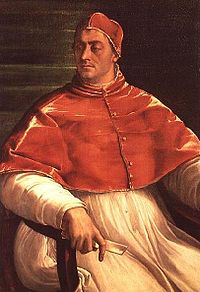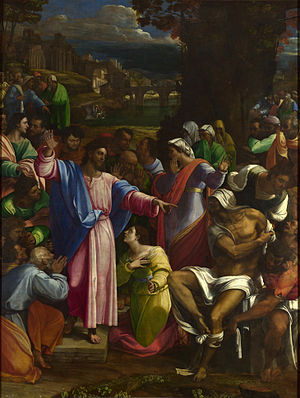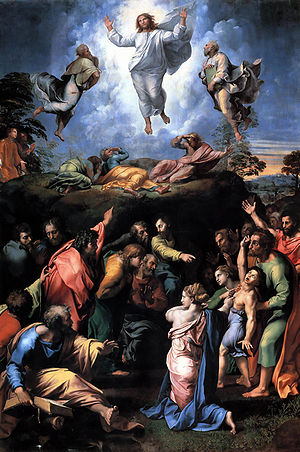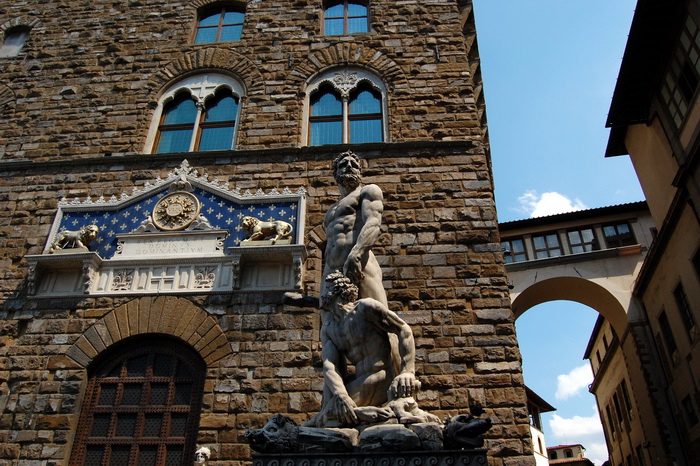
Pope Clement VII (Giulio de’ Medici) was the nephew of Lorenzo the Magnificent.
He was the illegitimate son of Giuliano de’ Medici (1453–1478) and Fioretta Gorini.
An intellectual and a renowned musician, he was a highly discriminating patron whose circle included Baldassare Castiglione and Paolo Giovio.
Educated at Padua University, he travelled extensively in Europe during the Medici exile from Florence (1494–1512).
When the Medici were restored to power, Giulio was appointed Archbishop of Florence and cardinal by his cousin Pope Leo X. He travelled to Rome in 1513 and became Papal Vice-Chancellor in 1517. He is depicted on the left in Raphael’s Leo X with Cardinals Giulio de’ Medici and Luigi de’ Rossi.
In late 1516 he commissioned Sebastiano del Piombo and Raphael to execute altarpieces for his archiepiscopal church, the cathedral of Narbonne, France: Sebastiano’s Resurrection of Lazarus and Raphael’s Transfiguration (pics bellow).


He continued the Medici patronage of Raphael and requested him to design a villa (later known as Villa Madama) outside Rome. Work began around 1518, with the assistance of Giulio Romano and Antonio da Sangallo II. Fresco decorations were painted by Giulio Romano, Giovanni da Udine and Giovanni Francesco Penni, and Baccio Bandinelli produced a pair of stucco Herculean Giants for the gardens. Only part of the villa was completed, and it was largely destroyed in 1527, in the Sack of Rome. Giulio governed Florence from 1519 onwards, and the marble sculpture of Orpheus he ordered from Bandinelli dates from that year. In 1520 he was involved with commissioning Pontormo’s lunette fresco of Vertumnus and Pomona for the saloneof the Medici villa at Poggio a Caiano.
Giulio was elected Pope, at the age of 45, on 19 November 1523 and took the title Clement VII: the decorations for his coronation were produced by Bandinelli. Clement continued the decoration by Giulio Romano and Penni of the Sala di Costantino, in which they incorporated a portrait of Clement as Pope Leo I. On 10 December 1523 Clement confirmed the commission given by Leo X to Michelangelo to design a chapel at San Lorenzo in Florence for Medici family tombs. In January 1524 he asked Michelangelo to design a library at S Lorenzo to display the Medici book collection to the public.
Numerous drawings exist for these two projects, and the surviving correspondence reveals Clement’s high degree of involvement: he requested an unusual design with small figures for the ceiling and asked Paolo Giovio to devise an inscription for the entrance to the reading-room of the Biblioteca Laurenziana; he even specified the type of wood to be used for the desks and ceiling of the library.
By 1525 Sebastiano had produced two further works for Clement; a head of Christ and a Holy Family; the latter is identified with the Holy Family with St John the Baptist.
In 1525 Clement commissioned Bandinelli to produce a statue of Hercules and Cacus (photo below) for the Piazza della Signoria, Florence as a pendant to Michelangelo’s David.

During the Sack of Rome on 6 May 1527, Clement took refuge in Castel Sant’Angelo; he then fled to Orvieto and Viterbo, where he remained in exile. After his return to Rome in October 1528, he vowed, according to Vasari, to order bronze statues of the Deadly Sins for the gate-tower of Castel Sant’Angelo to commemorate this traumatic event. The commission was given to Bandinelli but never executed. Sebastiano’s magnificent portrait of Clement VII dates from this period. Benvenuto Cellini, who was master of the Papal Mint from 1529 to 1534, produced seals, medals and finely wrought coins bearing the Pope’s portrait with the highly personal iconography of the obverses chosen by Clement himself. Cellini also produced a renowned papal morse.
After 1529 Clement concentrated his resources on completing the Medici Chapel and the Biblioteca Laurenziana. From November 1529 to March 1530 Clement was in Bologna to crown Charles V as Holy Roman Emperor, and Sebastiano drew a double portrait of them that currently is at the British Museum. In 1531 Clement rewarded Sebastiano for his loyalty by appointing him keeper of the papal seal, the Piombo. For the marriage of Henry II of France to Clement’s niece Catherine de’ Medici in 1533, Clement commissioned a jeweled unicorn’s horn as a gift. In August 1533 Clement commissioned Michelangelo to fresco the Last Judgement on the altar wall of the Sistine Chapel. Work was started only after Clement’s death. His tomb was begun by Bandinelli but completed by assistants after 1540.
